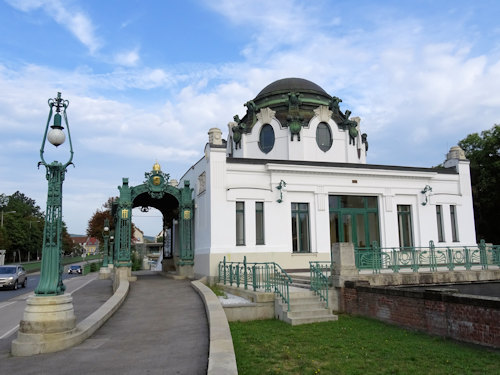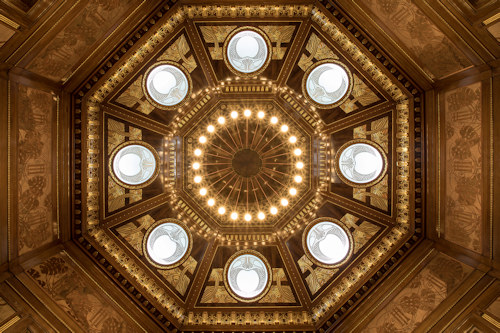
It’s tough being an Emperor. By your definition, everyone else is “beneath you”. Fortunately, there are ways and means of avoiding the unwashed masses, even when catching the train. Franz Joseph had his own private station entrance just outside his summer palace: the Hofpavillon at Hietzing station.
- The Emperor’s private railway pavilion built in 1899
- Architect Otto Wagner’s only “Imperial” building
- Small exhibition inside
- Limited opening hours (usually weekends in the warmer months)
- One-time entry for free with the Vienna Pass
- See also:
The history

(The green and white matches Wagner’s other station designs)
The expansion of Vienna’s Stadtbahn metropolitan railway system at the end of the 19th century included construction of the Wientallinie, a rail line which followed the course of the River Wien.
Architect Otto Wagner designed all the new stations, including the famous Karlsplatz pavilions.
Now, the Wientallinie route happened to pass Schönbrunn Palace, sometime residence of Emperor Franz Joseph.
Keen to get a foot in the door with the Imperial court, Wagner suggested building a station pavilion for Franz Joseph’s, one that would allow the monarch and his retinue private access to the railway.
The Emperor approved of Wagner’s proposal, leading to the opening of the Hofpavillon in 1899.

(The view from the Hietzing station bridge)
The Ver Sacrum periodical, official organ of the progressive Secession, praised the new building effusively and hoped it represented the beginning of the Wiener Moderne movement’s entry into the imperial construction market. Their description of the project ended so (my translation):
A triumph of modern art principles and a triumph for the artistic creator of the Stadtbahn
This success didn’t have quite the desired impact on Wagner’s order book, though. Great as his architectural achievements in Vienna were, the Hofpavillon would be his only Imperial building.
Incidentally, the Emperor only used the station twice. So, all-in-all, not a great return on investment.
It looks good, though.
Inside the Hofpavillon

(The main ceiling; press photo by Lisa Rastl and © Wien Museum)
Despite its small size, the Imperial Pavilion makes a striking impression with its lovely entrance and Baroque-style dome, all fully renovated and restored back in 2014.
The design blends the trademark simplicity and colours of the Stadtbahn stations with a dollop of Habsburg majesty, thereby elegantly bridging the worlds of functionality, modernism, and royalty.
That was my impression, anyway, but I may have got a bit flowery in the description.
You can work your way around the insides very quickly.
Beyond the ticket office is a beautiful octagonal room with mahogany panelling and dark silk wall coverings. Everything seems to tremble a little when a train passes underneath.

(Inside the Hofpavillon; press photo by Lisa Rastl and © Wien Museum)
That same room has an impressive painting by Carl Moll depicting an aerial view of Vienna that also shows the full extent of the new rail developments of the time.
The white-walled hall off to the left would have led to the platforms. Here you can see, for example, the original presentation drawings used to convince the court of the value of the building project. All information is presented in German and English.
Off to the right is another white room with information, drawings and photos covering the Stadtbahn, its stations, and the Imperial pavilion.
A smaller waiting room beyond the octagonal room has dark wood panelling and green silk wall coverings.
(You imagine the Emperor himself never had to actually sit in the waiting room with a bottle of water, bar of chocolate, and an eye on a display board. I rather suspect the train waited for him.)
Tickets & visitor tips

(The Austrian imperial crown tops the entranceway)
The Pavilion is part of the Wien Museum group of locations and has limited opening times. It typically opens during spring and summer (mid-March to October), Friday to Sunday only. At the time of writing, adult tickets were €5 with concessions available.
Some tips:
- It only takes a few minutes to look around, so you can easily fit in a quick trip while viewing the nearby palace and park (immediately opposite the pavilion)
- Stand on the bridge at the Hietzing station and look down the tracks in the direction of the city center; the pavilion hangs rather incongruously over the rail line and makes for a great photo.
- If you’re up for a pilgrimage to Otto Wagner’s grave, it’s not far away from here in the Hietzinger cemetery (see the map below), just a few steps from Gustav Klimt’s grave
- A Vienna Pass (see my review) gets you one-time free entry
How to get to the Hofpavillon
Simply go to Hietzing station and exit in the direction of the city centre: you’ll see the pavilion in the distance, less than a 100m walk away. Just be careful walking there, as it’s a popular cycle route and alongside a busy road.
Hietzing is on the following public transport lines: the U4 subway; the 10 and 60 tram lines; the 51A, 56A, 56B, and 58A bus lines.
Address: Schönbrunner Schloßstraße, 1130 Vienna | Website